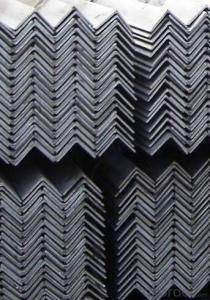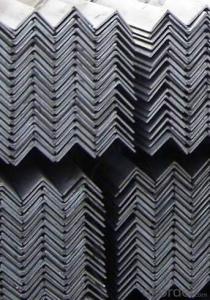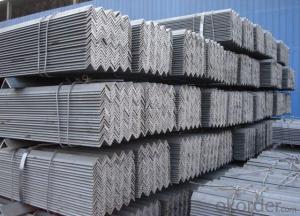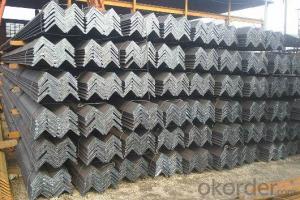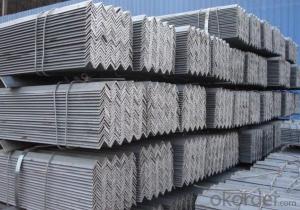Products Steel Angle Bar with High Quality
- Loading Port:
- Tianjin
- Payment Terms:
- TT or LC
- Min Order Qty:
- 25 m.t.
- Supply Capability:
- 20000 m.t./month
OKorder Service Pledge
OKorder Financial Service
You Might Also Like
Product Description:
OKorder is offering high quality Steel Angles at great prices with worldwide shipping. Our supplier is a world-class manufacturer of steel, with our products utilized the world over. OKorder annually supplies products to European, North American and Asian markets. We provide quotations within 24 hours of receiving an inquiry and guarantee competitive prices.
Product Applications:
Steel Angles are ideal for structural applications and are widely used in the construction of buildings and bridges, and the manufacturing, petrochemical, and transportation industries.
Product Advantages:
OKorder's Hot Rolled Steel Angles are durable, strong, and resist corrosion.
Main Product Features:
· Premium quality
· Prompt delivery & seaworthy packing (30 days after receiving deposit)
· Corrosion resistance
· Can be recycled and reused
· Mill test certification
· Professional Service
· Competitive pricing
Product Specifications:
Manufacture: Hot rolled
Grade: Q195 – 235
Certificates: ISO, SGS, BV, CIQ
Length: 6m – 12m, as per customer request
Packaging: Export packing, nude packing, bundled
Sizes: 25mm-250mm | ||
a*t | ||
25*2.5-4.0 | 70*6.0-9.0 | 130*9.0-15 |
30*2.5-6.6 | 75*6.0-9.0 | 140*10-14 |
36*3.0-5.0 | 80*5.0-10 | 150*10-20 |
38*2.3-6.0 | 90*7.0-10 | 160*10-16 |
40*3.0-5.0 | 100*6.0-12 | 175*12-15 |
45*4.0-6.0 | 110*8.0-10 | 180*12-18 |
50*4.0-6.0 | 120*6.0-15 | 200*14-25 |
60*4.0-8.0 | 125*8.0-14 | 250*25 |
FAQ:
Q1: Why buy Materials & Equipment from OKorder.com?
A1: All products offered byOKorder.com are carefully selected from China's most reliable manufacturing enterprises. Through its ISO certifications, OKorder.com adheres to the highest standards and a commitment to supply chain safety and customer satisfaction.
Q2: How do we guarantee the quality of our products?
A2: We have established an advanced quality management system which conducts strict quality tests at every step, from raw materials to the final product. At the same time, we provide extensive follow-up service assurances as required.
Q3: How soon can we receive the product after purchase?
A3: Within three days of placing an order, we will begin production. The specific shipping date is dependent upon international and government factors, but is typically 8 to 10 workdays.
Images:
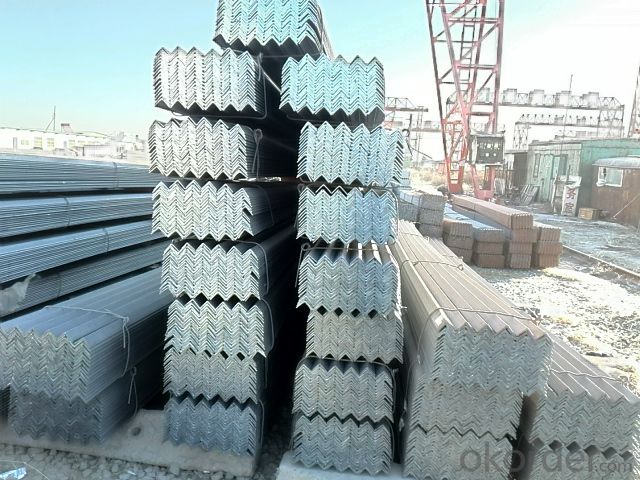
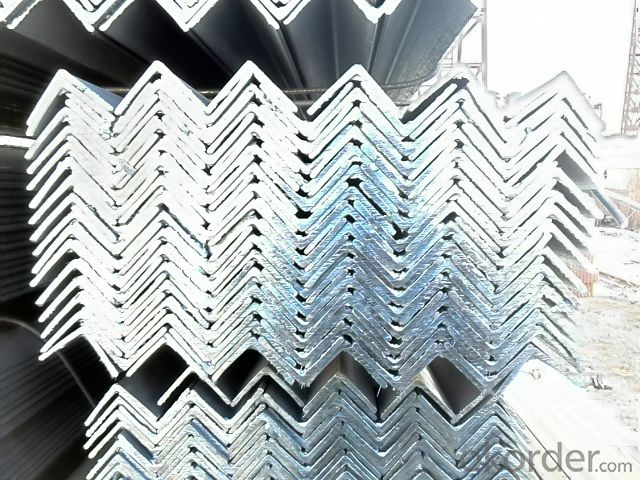

- Q: What are the different types of connections used for steel angles in industrial settings?
- In industrial settings, there are several types of connections used for steel angles depending on the specific application and structural requirements. Some of the commonly used connection types include: 1. Welded Connections: Welding is a popular method for connecting steel angles in industrial settings. It involves joining the angles using heat and pressure, resulting in a strong and durable connection. Welded connections are typically used when high strength and rigidity are required. 2. Bolting Connections: Bolts and nuts are used to connect steel angles in bolting connections. This type of connection allows for ease of assembly and disassembly, making it suitable for applications where flexibility and adjustability are important. Bolting connections can be easily tightened or loosened as needed. 3. Riveted Connections: Riveting involves using metal rivets to connect steel angles. This connection type offers good strength and stability and is commonly used in heavy-duty applications. Riveted connections require specialized equipment and skilled labor for installation and removal. 4. Adhesive Connections: Adhesives can also be used to bond steel angles together. This type of connection provides good load distribution and can be used in applications where welding or bolting is not feasible. Adhesive connections require proper surface preparation and adhesive selection to ensure adequate bonding strength. 5. Mechanical Connections: Mechanical connections such as cleats, brackets, plates, or clips can be used to connect steel angles. These connections provide flexibility and ease of installation, allowing for adjustments and modifications in the future if needed. It is important to note that the selection of the connection type depends on various factors such as the load-bearing capacity required, the structural design, safety considerations, and the specific environmental conditions in the industrial setting. Consulting with structural engineers and following industry standards and codes is crucial to ensure the appropriate type of connection is used for steel angles in industrial applications.
- Q: How do you prevent buckling of steel angles under compressive loads?
- To prevent buckling of steel angles under compressive loads, there are several measures that can be taken: 1. Increase the section modulus: The section modulus is a measure of the resistance of a cross-sectional shape to bending. By increasing the width or thickness of the steel angle, the section modulus can be increased, thereby enhancing its ability to resist compressive loads without buckling. 2. Increase the moment of inertia: The moment of inertia is a property of a cross-sectional shape that determines its resistance to bending. By increasing the moment of inertia, the steel angle becomes stiffer and less prone to buckling. This can be achieved by adding additional material or using a different cross-sectional shape with a greater moment of inertia. 3. Provide lateral support: Lateral support can be provided by adding bracing or stiffeners to the steel angle. This helps to distribute the compressive load and prevent buckling. The bracing or stiffeners should be designed to resist the applied loads and prevent any local distortions or deformations. 4. Use thicker or higher strength steel: By using thicker or higher strength steel, the steel angle can withstand higher compressive loads without buckling. Thicker steel has a higher resistance to bending, while higher strength steel can carry higher stresses before reaching its yield point. 5. Properly design and install connections: The connections between the steel angle and other structural members should be carefully designed and installed. Adequate connection details should be provided to ensure that the compressive load is transferred properly and that the steel angle is adequately supported. 6. Consider the effective length factor: The effective length factor is a parameter that accounts for the buckling behavior of a member. By properly considering the effective length factor in the design calculations, the risk of buckling can be minimized. 7. Conduct a thorough structural analysis: It is important to conduct a structural analysis to determine the expected compressive loads and potential buckling modes. By analyzing the structure using appropriate software or calculations, the necessary measures can be implemented to prevent buckling. Overall, preventing buckling of steel angles under compressive loads involves a combination of design considerations, material selection, and proper installation techniques. Following these measures will ensure the structural integrity and safety of the steel angles in various applications.
- Q: How do you transport steel angles safely?
- Transporting steel angles safely requires proper planning and adherence to specific guidelines. Here are a few steps to ensure the safe transportation of steel angles: 1. Secure the steel angles: Start by ensuring that the steel angles are properly secured before transportation. This can be done by using straps or chains to hold them in place. Make sure the angles are tightly secured to prevent any movement or shifting during transit. 2. Use suitable transportation equipment: Select the appropriate transportation equipment based on the quantity and size of the steel angles. Flatbed trucks or trailers with secure tie-down points are often used to transport steel angles. If necessary, consider using specialized equipment such as cranes or forklifts to load and unload the angles safely. 3. Protect the steel angles: To prevent damage during transit, it's crucial to protect the steel angles from potential hazards. This can be achieved by using suitable packaging materials such as cardboard or wooden crates to cover the angles and provide additional support. Additionally, consider using protective padding or blankets to prevent scratches or dents. 4. Ensure weight distribution: Proper weight distribution is essential to maintain stability during transportation. Make sure the load is evenly distributed across the transportation equipment to prevent imbalance or tipping. If necessary, consult weight distribution guidelines or seek professional advice to ensure safe transportation. 5. Follow local regulations: Familiarize yourself with local transportation regulations and guidelines. Ensure compliance with any specific requirements related to securing the load, maximum weight limits, or permits required for oversized shipments. This will help ensure legal compliance and safe transportation. 6. Inspect and maintain the transportation equipment: Regularly inspect the transportation equipment for any signs of wear and tear. Check the condition of straps, chains, or tie-down points to ensure they are in good working order. Properly maintained equipment reduces the risk of accidents or incidents during transportation. 7. Plan the route and consider weather conditions: Before transporting steel angles, plan the route carefully, taking into account any potential obstacles or road conditions that may impact safety. Be aware of any height or weight restrictions on certain roads or bridges. Additionally, consider weather conditions such as heavy rain, snow, or high winds, and adjust the transportation plan accordingly. By following these steps and taking necessary precautions, you can transport steel angles safely, minimizing the risk of damage, accidents, or injuries. Always prioritize safety and ensure compliance with applicable regulations for a successful transportation process.
- Q: Can steel angles be used in cold-formed steel construction?
- Yes, steel angles can be used in cold-formed steel construction. Cold-formed steel construction involves the use of thin gauge steel sheets that are formed into various shapes and profiles, including angles. Steel angles are commonly used in cold-formed steel construction for a variety of applications, such as framing systems, support members, and bracing elements. They provide structural strength, stability, and can be easily connected or welded to other cold-formed steel components. Additionally, steel angles can be customized and fabricated to meet specific project requirements and design specifications in cold-formed steel construction.
- Q: Can steel angles be used in earthquake-resistant building designs?
- Yes, steel angles can be used in earthquake-resistant building designs. Steel angles are commonly used in construction due to their strength and stability. When properly engineered and integrated into the design, steel angles can provide additional support and reinforcement to the building structure, making it more resistant to seismic forces during an earthquake.
- Q: What are the different types of steel angles connections for trusses?
- There are several types of steel angle connections commonly used for trusses, including gusset plate connections, bolted connections, welded connections, and clip angles.
- Q: What are the common uses of equal steel angles?
- Equal steel angles are a versatile and commonly used structural component in various industries. Some of the common uses of equal steel angles include: 1. Construction: Equal steel angles are frequently used in construction projects, particularly for framing, support, and bracing structures. They are commonly used in the construction of buildings, bridges, and other infrastructure projects. 2. Manufacturing: Equal steel angles are also widely used in manufacturing industries, such as automotive, machinery, and shipbuilding. They are utilized in the fabrication of frames, chassis, supports, and various other structural components. 3. Shelving and Racking: Equal steel angles are often used in the construction of shelving and racking systems. They provide strength and stability to support heavy loads and are commonly used in warehouses, retail stores, and industrial facilities. 4. Fencing and Security: Equal steel angles are commonly used in the construction of fences and gates. They provide a strong and durable framework for securing properties, creating boundaries, and protecting assets. 5. Stairs and Handrails: Equal steel angles are frequently used in the construction of stairs and handrails. They provide support and stability to ensure safe and functional access to different levels in buildings, walkways, and outdoor structures. 6. Infrastructure and Utilities: Equal steel angles are utilized in various infrastructure and utility projects, including electrical transmission towers, telecommunications masts, and solar panel installations. They provide the necessary support and stability for these structures. 7. Agricultural and Farming: Equal steel angles are commonly used in the agricultural and farming industry for constructing fences, gates, and animal enclosures. They provide a durable and secure framework for containing livestock and protecting crops. 8. Decorative and Architectural: Equal steel angles are also used for decorative and architectural purposes. They can be utilized to create unique and aesthetically pleasing designs in buildings, furniture, and other decorative applications. Overall, equal steel angles have numerous applications across different industries due to their strength, versatility, and cost-effectiveness. Whether it is for construction, manufacturing, infrastructure, or decorative purposes, equal steel angles play a vital role in providing structural support and stability.
- Q: How do you calculate the stability of a steel angle column?
- The stability of a steel angle column can be calculated using various methods, such as the Euler buckling formula or the interaction equation. These methods involve considering factors such as the load applied, the column's length, the material's properties, and the column's cross-sectional area. By analyzing these parameters, engineers can determine the critical buckling load or the factor of safety, which reflects the column's stability.
- Q: What are the common welding techniques used for steel angles?
- The common welding techniques used for steel angles include MIG (Metal Inert Gas) welding, TIG (Tungsten Inert Gas) welding, and stick welding (Shielded Metal Arc Welding - SMAW). MIG welding, also known as GMAW (Gas Metal Arc Welding), is a widely used technique that involves feeding a continuous wire electrode into the weld pool while an inert gas, such as argon or a mixture of argon and carbon dioxide, is used to shield the weld zone from atmospheric contamination. MIG welding is known for its ease of use, high welding speeds, and ability to handle thicker materials. TIG welding, also known as GTAW (Gas Tungsten Arc Welding), is a more precise welding technique that uses a non-consumable tungsten electrode to create the arc and a separate filler material if necessary. TIG welding provides excellent control over the weld pool and produces high-quality welds with minimal spatter. It is commonly used for thinner materials and applications that require a higher level of precision. Stick welding, also known as SMAW (Shielded Metal Arc Welding), is a versatile and widely used welding process. It involves striking an arc between a flux-coated electrode and the workpiece, creating a weld pool that is protected by the flux coating. Stick welding is known for its portability and ability to handle various materials and thicknesses. It is commonly used in construction, maintenance, and repair work. These welding techniques can be used for steel angles, which are often found in structural applications, such as frames, braces, and supports. The selection of the welding technique depends on factors such as the thickness of the steel angle, the required weld quality, and the specific application. It is important to consider the welding process, proper joint preparation, and welding parameters to ensure a strong and durable weld joint.
- Q: Can steel angles be used for underground or subterranean structures?
- Yes, steel angles can be used for underground or subterranean structures. Steel angles provide excellent structural support and can withstand the high pressure and load-bearing requirements typically associated with underground or subterranean construction. They offer durability, strength, and flexibility, making them suitable for various applications in such environments.
Send your message to us
Products Steel Angle Bar with High Quality
- Loading Port:
- Tianjin
- Payment Terms:
- TT or LC
- Min Order Qty:
- 25 m.t.
- Supply Capability:
- 20000 m.t./month
OKorder Service Pledge
OKorder Financial Service
Similar products
Hot products
Hot Searches
Related keywords
